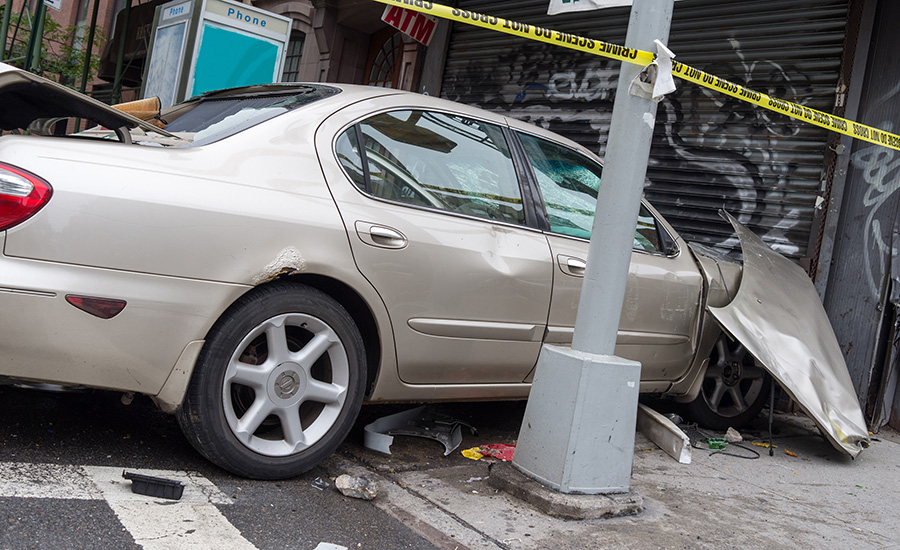Most property damage claims result from floods, fires, or storm-related occurrences. However, restorers also encounter unusual claims, such as automobiles that collide into buildings.
When a car impacts a building, tremendous forces are exerted that can cause major damage to the structure. For example, a car that weighs 2,000 lbs. traveling at 60 miles per hour exerts a force of 490,914 Newtons, which in this example would be roughly the equivalent of 1.1 million lbs. of force. This amount of force can easily destroy walls constructed of wood, masonry, or even reinforced concrete.
Other than the obvious visible damage to the exterior of the structure and interior elements, there are many issues restorers need to consider when restoring buildings damaged in these incidents.
Emergency Services
When restoration contractors are called to provide emergency services after a vehicular collision, certain safety precautions need to be taken. Here are a few to consider:
- The electrical system should be carefully inspected and shut off if there are signs of damage, as this could potentially cause a fire.
- Gas lines and fittings should be checked to see if they have been impacted, bent, or damaged. Even a tiny leak at a fitting could lead to a dangerous buildup of gas and cause an explosion.
- Water lines should be checked to ensure they are not leaking or damaged.
- Containments and air filters should be set up to prevent dust from migrating into unaffected rooms.
- In situations where load-bearing walls, posts, or beams are compromised or destroyed, adequate shoring should be installed. This will help support structural components that may be at risk of collapse.
Lastly, the exterior of the building should be properly secured to prevent unauthorized entry or theft.
Hazardous Materials
In older buildings, a vehicular impact can release hazardous materials such as asbestos or lead-based paint dust into the air.
Building materials suspected of containing hazardous substances should be tested before cleanup, demolition, or the moving of personal property. If a collision causes asbestos or lead to become airborne, the dust can contaminate the entire interior of the building.
Other potentially hazardous materials may include dust containing silica, a known carcinogen, or contaminants from the vehicle itself.
Exhaust fumes, smoke, and any automotive fluid leaks will require extensive remediation, cleaning, and deodorization.
Plumbing Damage
If plumbing pipes are affected by the impact, be sure to check all fittings, shut off valves, supply lines, and fixtures. If gas lines need to be repaired, have a plumber cap and pressurize the entire gas system before turning it back on and lighting any pilot lights.
Electrical Damage
Electrical wires that feed wall outlets or switches are often affected in vehicular collisions. Stretched or broken wires near the impact location can also cause damage to electrical panels. If electrical wiring is damaged, shut off the circuit(s) that feed the affected areas and have an electrician thoroughly check the wiring runs, junction boxes, breaker panels, and fixtures.
HVAC Damage
Other than physical damage to a furnace, air conditioner, or ductwork, dust and debris from the impact can be a serious issue. Oftentimes dust from plaster or drywall, bits of insulation, and smoke from the vehicle will find its way into ductwork, cold air returns, and furnace filters. Clean or replace ductwork and filters in areas that may have had dust, vehicle fumes, or smoke damage.
Wall Movement, Cracking, and Collapse
Another type of damage that often goes unnoticed is the transfer of impact force to connecting walls, roof structure, or chimneys. Sometimes cracks will not appear until the very end of an opposing or adjoining wall. Check chimney brick and mortar joints for cracks. Look inside the firebox and around the hearth for evidence of broken mortar, brick, or flue liner.
Door jambs and window frames can easily be wracked out of square after an impact. Check them to ensure they open and close properly, and that the reveal spacing around the openings is even.
Using a builder’s level or plumb bob are good ways to determine if walls have wracked out of plumb or alignment.
In situations where a floor or roof system has collapsed near a public thoroughfare, street, or sidewalk, great care must be taken to protect the public from falling debris and other dangers. Cordon off the area, install temporary fencing, and if necessary, hire a security guard to watch the area until conditions are safe.
Damages to Finishes and Fixtures
Brittle, fragile, and absorbent building materials, fixtures, and finishes are particularly susceptible to damage from motor vehicle impacts. Look for hairline cracks around the corners of door or window openings, especially if the walls and ceilings are finished with drywall, plaster, or stucco. Closely inspect ceramic tiles or glass blocks around tub or shower enclosures, glass windowpanes, porcelain toilets or sinks, etc.
Acoustic ceiling tiles and popcorn ceiling finishes are porous, absorbent materials that can retain odors, fumes, and particulate matter. If these materials are in or near the area of a vehicle impact, they may need to be removed and replaced.
Lastly, it is always a good practice to have a structural engineer evaluate any damage resulting from a vehicle impact and provide a detailed repair plan and protocol.


